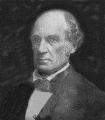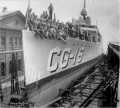Click On Image
For Full Size Image |
Size |
Image Description |
Contributed
By |
Namesake
|
 |
109k | George Edmund Badger was born on 17 April 1795 in New Bern, North Carolina. Following a partial college education at Yale, he studied law and was admitted to the bar in 1814. Badger practiced law in North Carolina, was active in state politics and held public office on occasion. A supporter of Andrew Jackson from the 1820s, he separated with him in the mid-1830s, became a leader of the Whig party and helped carry the Whigs to victory in the 1840 Presidential election. Upon taking office, President William Henry Harrison appointed George E. Badger as his Secretary of the Navy, and he continued in that post when John Tyler succeeded to the Presidency upon Harrison's death. Badger's brief term as Secretary was marked by efforts to strengthen the Navy in the face of tension with Great Britain, the establishment of the Home Squadron and continued interest in steamships. Badger resigned in September 1841, during a general cabinet shakeup. He was elected to the United States Senate in 1846 and remained a Senator until 1855. His political activities continued into the 1860s, when he was a Unionist during the secession crisis but thereafter supported the Confederate war effort. George E. Badger died in Raleigh, North Carolina, on 11 May 1866. | Bill Gonyo/Tom Kerman |
USS George E. Badger (DD-196)
|
THE SECRETARY OF THE NAVY
WASHINGTON
The President of the United States takes pleasure in presenting the PRESIDENTIAL UNIT CITATION to the
UNITED STATES SHIP BOGUE
with her Embarked Planes and Escort Vessels constituting the Five Task Groups listed below for service as set forth in the following
Citation:
"For outstanding performance in combat against enemy submarines in the Atlantic Area from April 20, 1943, to July 3, 1944. Carrying out powerful and sustained offensive action during a period of heavy German undersea concentrations threatening our uninterrupted flow of supplies to the European Theater of operations, the U.S.S. BOGUE, her embarked planes and her escorts tracked the enemy packs relentlessly and, by unwavering vigilance, persistent aggressiveness and perfect cooperation of all units involved, sank a notable number of hostile U-boats. The superb leadership of the BOGUE and the gallant spirit of the officers and men who fought her planes and manned her escort vessels were largely instrumental in forcing the complete withdrawal of enemy submarines from supply routes essential to the maintenance of our established military supremacy."
United States Ships Bogue, Lea, Greene, Belknap, Osmond Ingram, George E. Badger, and VC-9 from April 20 to June 20, 1943.
United States Ships Bogue, Osmond Ingram, George E. Badger, Clemson, and VC-9 from July 12 to August 23, 1943.
United States Ships Bogue, Osmond Ingram, George E. Badger, Clemson, Dupont and VC-19 from November 14 to December 29, 1943.
United States Ships Bogue, Haverfield, Swenning, Willis, Hobson (until March 25), Janssen (until April 7) and VC-95 from February 26 to April 19, 1944.
United States Ships Bogue, Haverfield, Swenning, Willis, Janssen, F. W. Robinson, and VC-69 from May 4 to July 3, 1944.
For the President,
James Forrestal
Secretary of the Navy |

0519611 |
25k | The future USS George E. Badger (yard number 238) and Welborn C. Wood (yard number 237) under construction at Newport News, circa late 1919 - early 1920. | Dave Wright |
 |
125k | USS George E. Badger (DD-196), Moored in a nest with two other destroyers, circa 1920.
Naval History and Heritage Command photo NH 76376, courtesy of Donald M. McPherson, 1972. | Curt Clark/Robert Hurst/Darryl Baker |
 USCGC George E. Badger (CG-16) USCGC George E. Badger (CG-16)
|
 |
25k | Seen here as the USCGC George E. Badger (CG-16) at Naval Station Key West, FL, circa 1933. | Joe Radigan |
 |
160k | Members of the crew of the Coast Guard Cutter George E. Badger (CG-16) pictured on board the ship while in the Marine Railway at the Boston Navy Yard, May 1933. Photo courtesy of the National Naval Aviation Museum. | Bill Gonyo |

